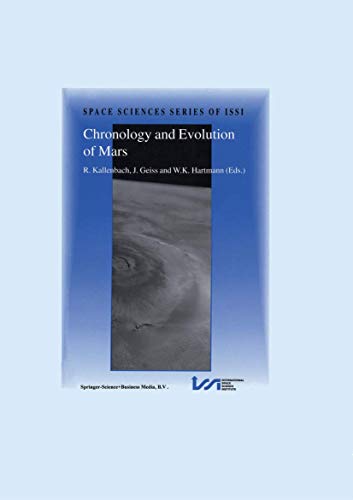Verwandte Artikel zu Chronology and Evolution of Mars: Proceedings of an...
Chronology and Evolution of Mars: Proceedings of an ISSI Workshop, 10¿14 April 2000, Bern, Switzerland: 12 (Space Sciences Series of ISSI) - Hardcover

Zu dieser ISBN ist aktuell kein Angebot verfügbar.
Alle Exemplare der Ausgabe mit dieser ISBN anzeigen:„Über diesen Titel“ kann sich auf eine andere Ausgabe dieses Titels beziehen.
- VerlagSpringer
- Erscheinungsdatum2001
- ISBN 10 0792370511
- ISBN 13 9780792370512
- EinbandTapa dura
- Auflage1
- Anzahl der Seiten500
- HerausgeberKallenbach R., Geiss Johannes, Hartmann W.K.
Neu kaufen
Mehr zu diesem Angebot erfahren
Versand:
EUR 48,99
Von Deutschland nach USA
Beste Suchergebnisse bei AbeBooks
Chronology and Evolution of Mars
Buchbeschreibung Gebunden. Zustand: New. Bestandsnummer des Verkäufers 5969879
Weitere Informationen zu diesem Verkäufer | Verkäufer kontaktieren
Chronology and Evolution of Mars
Buchbeschreibung Buch. Zustand: Neu. This item is printed on demand - it takes 3-4 days longer - Neuware -Mars is about one-eighth the mass of the Earth and it may provide an analogue of what the Earth was like when it was at such an early stage of accretion. The fur ther growth of the Earth was sustained by major collisions with planetesimals and planets such as that which resulted in the formation ofthe Earth's moon (Hartmann and Davis, 1975; Cameron and Ward, 1976; Wetherill, 1986; Cameron and Benz, 1991). This late accretionary history, which lasted more than 50 Myr in the case of the Earth (Halliday, 2000a, b), appears to have been shorter and less catastrophic in the case of Mars (Harper et ai. , 1995; Lee and Halliday, 1997). In this article we review the basic differences between the bulk composition of Mars and the Earth and the manner in which this plays into our understanding of the timing and mechanisms of accretion and core formation. We highlight some of the evidence for early cessation of major collisional growth on Mars. Finally, we reevaluate the isotopic evidence that Mars differentiated quickly. Fundamental differences between the composition of Mars and that of other terrestrial planets are apparent from the planet's slightly lower density and from the compositions of Martian meteorites. The low density is partially explicable if there is a greater proportion of more volatile elements. 512 pp. Englisch. Bestandsnummer des Verkäufers 9780792370512
Weitere Informationen zu diesem Verkäufer | Verkäufer kontaktieren
Chronology and Evolution of Mars : Proceedings of an ISSI Workshop, 10¿14 April 2000, Bern, Switzerland
Buchbeschreibung Buch. Zustand: Neu. Druck auf Anfrage Neuware - Printed after ordering - Mars is about one-eighth the mass of the Earth and it may provide an analogue of what the Earth was like when it was at such an early stage of accretion. The fur ther growth of the Earth was sustained by major collisions with planetesimals and planets such as that which resulted in the formation ofthe Earth's moon (Hartmann and Davis, 1975; Cameron and Ward, 1976; Wetherill, 1986; Cameron and Benz, 1991). This late accretionary history, which lasted more than 50 Myr in the case of the Earth (Halliday, 2000a, b), appears to have been shorter and less catastrophic in the case of Mars (Harper et ai. , 1995; Lee and Halliday, 1997). In this article we review the basic differences between the bulk composition of Mars and the Earth and the manner in which this plays into our understanding of the timing and mechanisms of accretion and core formation. We highlight some of the evidence for early cessation of major collisional growth on Mars. Finally, we reevaluate the isotopic evidence that Mars differentiated quickly. Fundamental differences between the composition of Mars and that of other terrestrial planets are apparent from the planet's slightly lower density and from the compositions of Martian meteorites. The low density is partially explicable if there is a greater proportion of more volatile elements. Bestandsnummer des Verkäufers 9780792370512
Weitere Informationen zu diesem Verkäufer | Verkäufer kontaktieren

